
The Treasury Note (also known as a Coin Note) was a type of representative money issued by the United States government from 1890 until 1893 under authority of the Sherman Silver Purchase Act in denominations of $1, $2, $5, $10, $20, $50, $100 and $1,000. It was issued in two series: an 1890 series with $1, $2, $5, $10, $20, $100 and $1,000 denominations, and an 1891 series that added the $50 denomination. A $500 note was designed but never issued.
Usage
The government issued the Treasury Note to individuals selling silver bullion to the Treasury. Unlike other redemption notes like silver and gold certificates (which stipulated whether the note was backed by and redeemable for silver or gold coin, respectively), Treasury Notes stipulated only that they were redeemable in coin. This allowed the Treasury to fulfil the note's obligation in silver coin, gold coin, or both, at its discretion when the note was redeemed. This flexibility allowed the Treasury some control over releasing gold or silver when the relative value of the two metals fluctuated. The origin of the term "Coin Note" to describe the note is unclear – it may refer either to the coin it could be exchanged for, or derive from the fact that it was issued to pay for silver that would later be turned into coins.
Description
Treasury Notes are large-size (average dimension is 7.375 by 3.125 inches ) banknotes. The portrait of General George Meade on the $1,000 Note was engraved by renowned artist and line engraver Charles Burt. The 100 Greatest American Currency Notes, a 2006 book by Q. David Bowers and David Sundman, put the $1,000 Treasury Note (Fr#379b), nicknamed the "Grand Watermelon", at the top of its list. Of the seven "Grand Watermelon" notes known to exist today, only three are available to collectors: two of the Large Brown Treasury Seal variety (Fr#379a), pictured above; and only one example of the Small Red Treasury Seal variety (Fr#379b).
A distinguishing feature of the Series 1890 notes (and one that greatly appeals to collectors) is the extremely ornate designs on the reverse side of the notes. The intent of this was to make counterfeiting much more difficult, but opponents of the design argued that the extensive detail would make it more difficult to distinguish between genuine and counterfeit notes. Consequently, the reverse designs were simplified on the Series 1891 Treasury Notes issued the following year.
Auction history
On January 10, 2014, at the annual Florida United Numismatist convention, in Orlando, Florida, Heritage Auctions sold a Series 1890 $1,000 Treasury Note (Fr#379b) for $3,290,000, setting a new world record price for paper currency. The same note had set a record in December 2006 when it was sold for $2,255,000 in a private sale. The note was previously auctioned in 1944 for $1,230 and in 1970 for $11,000.
The other variety of $1,000 Treasury Notes, Series 1891 "Open Backs" (Fr#379c), represented by just two notes, has also been involved in the recent string of record-breaking sales. While one of these two notes is owned by the Smithsonian Institution (pictured at bottom), the only Series 1891 $1,000 note available to collectors had set the world record in March 2006. It again set the record in April 2013, when it was sold at public auction by Heritage Auctions for $2,585,000 at the Central States Numismatic Convention, in Chicago, Illinois.
Gallery of Treasury Note images
The Treasury Notes pictured below are from the 1890 and 1891 series. Images are from the National Numismatic Collection at the National Museum of American History (Smithsonian Institution).
| Value | Series | Fr. | Image | Portrait | Classification/variety |
|---|---|---|---|---|---|
| 1$1 | 1890 | Fr.347 | 
|
Stanton1Edwin Stanton |
347 – Rosecrans and Huston – large brown. |
| 1$1 | 1891 | Fr.351 | 
|
Stanton1Edwin Stanton |
350 – Rosecrans and Nebecker – small red. |
| 2$2 | 1890 | Fr.353 | 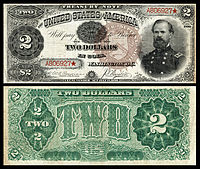
|
McPherson1James McPherson |
|
| 2$2 | 1891 | Fr.357 | 
|
McPherson1James McPherson |
|
| 5$5 | 1890 | Fr.361 | 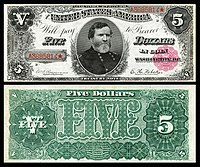
|
Thomas1George H. Thomas |
|
| 5$5 | 1891 | Fr.365 | 
|
Thomas1George H. Thomas |
|
| 10$10 | 1890 | Fr.367 | 
|
Sheridan1Philip Sheridan |
|
| 10$10 | 1891 | Fr.371 | 
|
Sheridan1Philip Sheridan |
|
| 20$20 | 1890 | Fr.374 | 
|
Marshall1John Marshall |
|
| 20$20 | 1891 | Fr.375a | 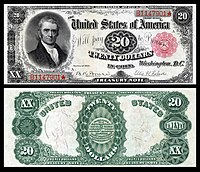
|
Marshall1John Marshall |
375 – Tillman and Morgan – small red. |
| 50$50 | 1891 | Fr.376 | 
|
SewardWilliam Seward | 376 – Rosecrans and Nebecker – small red. |
| 100$100 | 1890 | Fr.377 | 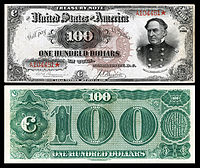
|
Farragut1David Farragut | 377 – Rosecrans and Huston – large brown. |
| 100$100 | 1891 | Fr.378 | 
|
Farragut1David Farragut | 378 – Rosecrans and Nebecker – small red. |
| 500$500 | 1891 | 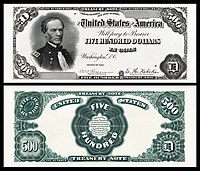
|
ShermanWilliam Tecumseh Sherman |
379 – Bruce and Roberts – small red. | |
| 1000$1,000 | 1890 | Fr.379a | 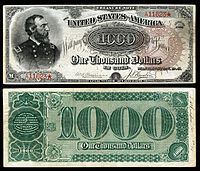
|
Meade1George Meade |
|
| $1,000 | 1890 | Fr.379b | George Meade | *379b - Rosecrans and Nebecker - small red | |
| 1000$1,000 | 1891 | Fr.379c | 
|
Meade1George Meade |
|
Notes
- "Fr" numbers refer to the numbering system in the widely used Friedberg reference book. These reference numbers indicate varieties existing within a larger type design based on (among other things) variations in design, seal type, Treasury signature combinations, etc. .
References
- Hessler, Gene and Chambliss, Carlson (2006). The Comprehensive Catalog of U.S. Paper Money, 7th edition, Port Clinton, Ohio: BNR Press ISBN 0-931960-66-5.
- ^ Currency Notes (PDF). US Bureau of Engraving and Printing. Retrieved January 16, 2014.
- Hessler, Gene (1979). U.S. Essay, Proof and Specimen Notes, Portage, Ohio: BNR Press ISBN 0-931960-04-5.
- Friedberg, Arthur L.; Friedberg, Ira S. (2010). Paper Money of the United States: A Complete Illustrated Guide With Valuations, 19th Edition (19th ed.). Coin & Currency Institute. p. 7. ISBN 978-0-87184-519-1. Retrieved September 10, 2013.
- Chapin, Willis O. (1894). The Masters and Masterpieces of Engraving, New York: Harper & Brothers Publishers.
- Keppel, Frederick (1910). The Golden Age of Engraving, New York: The Baker & Taylor Company.
- ^ "Heritage Sets World's Paper Money Record" (Press release). December 16, 2006. Retrieved January 16, 2014.
- ^ "Fr. 379b $1,000 1890 Coin Note PCGS Extremely Fine 40". Heritage Auctions. Retrieved January 16, 2014.
- "Fr. 379a $1,000 1890 Treasury Note PCGS Apparent Extremely Fine 45". Heritage Auctions. Retrieved March 6, 2014.
- "'Grand Watermelon' Note is World's Most Valuable Currency and Other Surprising Auction Items". ABC News. Retrieved January 17, 2014.
- "Fr. 379c $1,000 1891 Treasury Note PCGS Extremely Fine 45PPQ". Heritage Auctions. Retrieved March 6, 2014.
| Obsolete United States currency and coinage | |||
|---|---|---|---|
| Topics | |||
| Coins |
| ||
| Currency | |||
| Related | |||